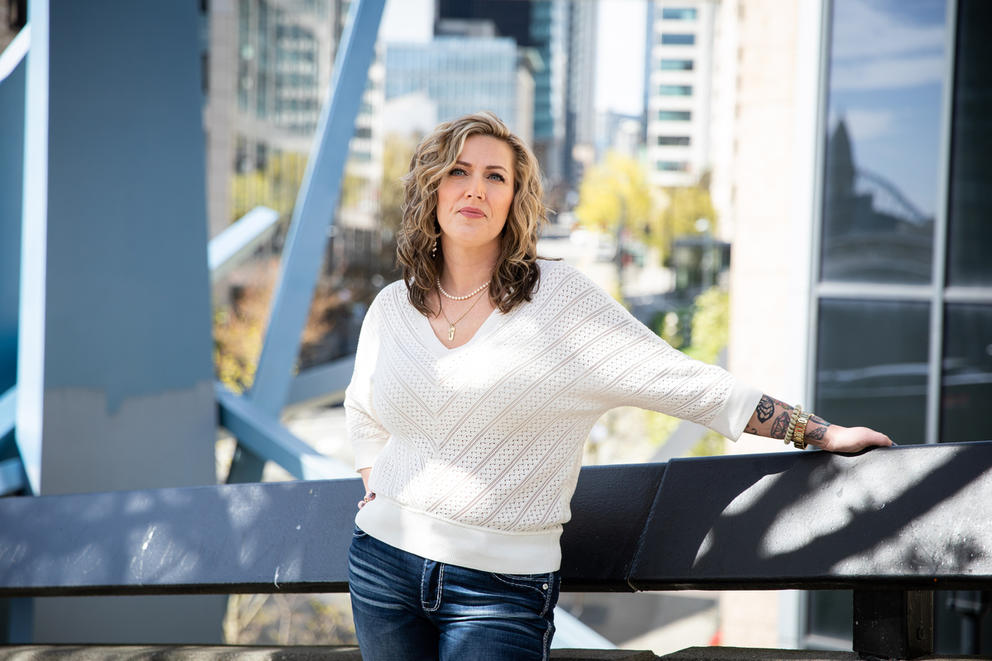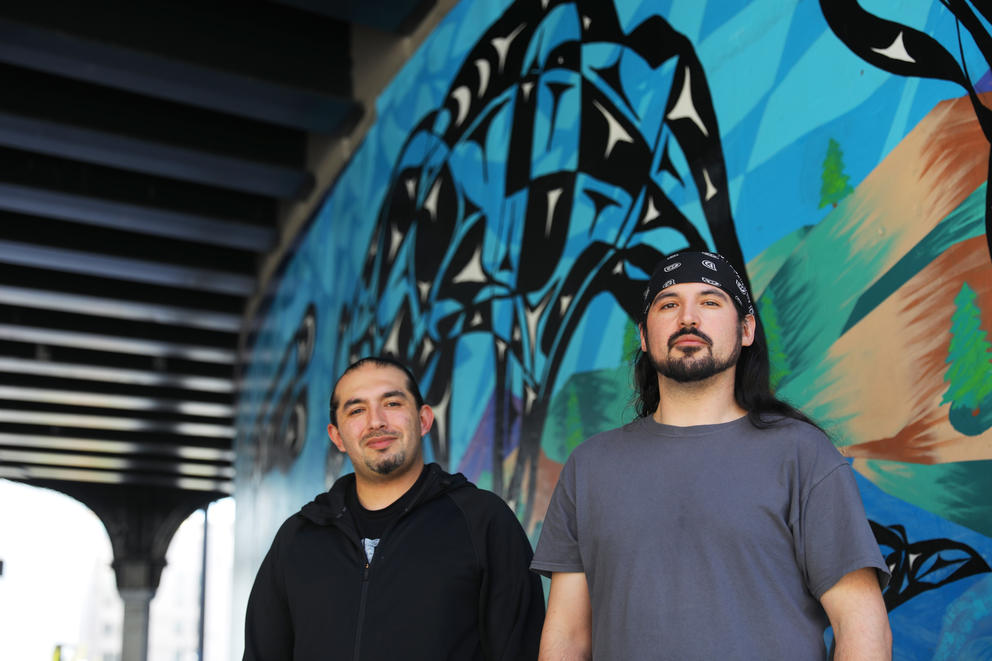Shepard traces her long path into homelessness back to the trauma of her father dying when she was a child, marking the beginning of her own mental health and behavioral issues. Addiction and alcoholism on both sides of the family predisposed her to her own struggles with addiction.
Her journey from addiction to homelessness to recovery is not uncommon in her chosen career in homeless outreach. She is now one of four co-directors for the King County Regional Homelessness Authority’s new Systems Advocates program. The program will use a team of peer navigators, who themselves have experienced homelessness and other traumas, to help guide people through the system.
“I found a purpose for my life that I never thought possible,” Shepard said. “I can identify with the fact that many of my clients have resigned themselves to this being how they're going to die. … But I'm a walking testimony. I can give you hope that this doesn't have to be the end of your story.”
For Shepard, teenage drug experimentation grew into a lasting problem. Eventually, the toxic combination of mental health problems, addiction and a lack of a healthy support network led to two years of homelessness spent mostly couch surfing and living in her car.
Shepard ended up in prison — itself a traumatizing experience — but didn’t get any form of rehabilitation that helped her. Not long after her release, she got a DUI and once again faced incarceration.
It was then that she decided she wanted help, begging the prison system to let her enter its therapeutic community, where she spent nearly 2½ years in intensive therapy.
Shepard was released into the Irma Gary House, a women’s transitional facility in Tacoma, where she began rebuilding her life. She got help with everything from receiving her driver’s license again to dealing with child support to relearning the social and life skills necessary to get housing and a job.
Once back on her feet, Shepard was brought to homeless outreach work by a coincidence. Her boyfriend at the time worked with Seattle’s Navigation Team, a now disbanded group of city outreach workers. Shepard would argue with him about how the work should be done. He convinced her she should give it a try and introduced her to REACH, a Seattle outreach nonprofit.
Shepard spent about three years at REACH. Bringing that shared experience and empathy to her work allowed her to bond with clients in a way she said is difficult for people who haven’t experienced homelessness.
“It makes a connection that you cannot possibly have unless you've been in the same foxhole,” said Shepard. “It’s understanding the subtleties of the language, the culture, the reality of things that aren't written down on paper about treatment programs, shelter systems, all the things that somebody from the outside looking in is just not going to understand is part of the equation.”
To illustrate her point, Shepard tells a story about going with the CEO of a homeless services nonprofit to visit a new client. The client came out of his RV angry, cussing out the CEO. But when the client said he had just gotten out of prison, and Shepard was able to say she had as well, there was an instant cooling. “All of a sudden we were OK. [The shared experience] breaks down barriers,” she said.
It is that exact sort of connection and trust the King County Regional Homelessness Authority hopes will help finally move the needle on the homelessness crisis through the new Systems Advocates program.
As a proof of concept, the Homelessness Authority is targeting Seattle’s greater downtown area, from Belltown to the Chinatown-International District. It estimates there are between 800 and 1,200 homeless people living in the area. The goal of the advocates program is to get that down to a few dozen — a manageable number of people who can be helped much more readily.
The Homelessness Authority plans to hire 30 to 40 systems advocates to do the frontline work, although the authority’s senior director of health initiatives, Dr. Shay Martinez, said that number could eventually expand to about 70. Martinez explained that, ideally, each systems advocate would work with about 15 clients so the program can provide intensive case management.
In their roles as King County support services specialists, Kirk Rodriguez, right, and Joe Barnhart walk the area around the King County Courthouse and City Hall Park, as they build relationships with those who live or hang out in that area of downtown. They sometimes provide food, sometimes emergency services, and sometime just an open ear, using their own lived experiences with homelessness to form connections. (Genna Martin/Crosscut)
The systems advocates’ lived experience with homelessness and other issues is one key piece of the model. Another is that each advocate will stay with clients from first contact to finding shelter to getting medical care and other needed treatment to, hopefully, finding permanent housing.
The current homelessness system operates far more in silos. One person from one organization does street outreach. The client is then passed on to another organization providing shelter. Another organization may take care of treatment. Another provides permanent housing. People have many opportunities to fall through the cracks or move back to the streets.
“It’s about having someone there who has your back so that you’re not alone in doing this,” said Shepard. “We can problem solve and figure something out. It doesn’t have to be back to square one if something goes wrong.”
“We’re not necessarily trying to create new systems for everything we have,” said Martinez. “We’re trying to get people to actually use the system in a way that’s appropriate for them and accessible for them.”
The Systems Advocate program is one piece of a broader effort called Partnership for Zero. The work is being paid for by $10 million in donations from Steve and Connie Balmer’s philanthropy, Amazon, Microsoft, Starbucks, the Bill and Melinda Gates Foundation and a host of other big businesses operating under the banner “We Are In.”
In addition to the systems navigators, Partnership for Zero will create a “unified command center” to coordinate the region’s homelessness response and provide a single point of contact for peoples’ concerns. The program will also create and use a “by-name” list, which would help service providers keep track of who is living on the street, what their individual needs are and where they might be able to get help. It’s a tactic experts say has helped the region address homelessness among veterans.
There’s no question that paying living wages and providing intensive case management with a much smaller outreach worker-to-client ratio would be more expensive than the existing model.
But Steve Berg, vice president of policy at the National Alliance to End Homelessness, argued that it’s likely to save money in the long run if it proves effective.
“People being homeless costs city government and society so much money,” said Berg. “Even marginal improvements in the potential to get someone housed is going to save money.”
Martinez said that the Homelessness Authority will be able to use Medicaid to reimburse the costs of the advocates’ work as well.
It is fairly common for homeless outreach workers to have experienced homelessness themselves. But according to Berg, the use of peer navigators has not been widely adopted at a systems level around the country.
Peer navigation has become commonplace in other fields, however, including behavioral health, mental health, addiction treatment and HIV/AIDS treatment.
The King County Behavioral Health and Recovery Division has been using peer navigators in a variety of roles since 2007, including mental health counseling, career services, reentry support for people leaving psychiatric hospitals, crisis intervention and more.
“Peer navigation doesn’t work for everybody, but for a lot of people it’s the key to giving people hope and knowing that recovery is possible,” said Kelli Nomura, director of the Behavioral Health and Recovery Division. “Peers are communicating that there is a path to recovery. When you’re struggling, especially in a mental health crisis, you lose all that perspective.”
Kirk Rodriguez is a support services specialist with King County’s City Hall Park neighborhood outreach team, which launched last fall. His job is to connect with people in a five-block radius of the park to provide crisis prevention and intervention services.
Every hour, Rodriguez makes the rounds, checking in with people living and hanging out in the south end of downtown to see what their needs are and build relationships with them. Sometimes he provides food or supplies. Other times he connects people to medical care or helps them access benefits such as an EBT food stamp card or the Housing and Essential Needs program.
Rodriguez was homeless for eight years and said it gives him a deeper empathy and understanding of the subtleties of his client’s experience.
“Having lived through [homelessness], I can, to a degree, better understand people's direct needs,” he explained. “How to talk to someone. Someone's fears. Someone's concerns. Understanding how to connect with people about their situation, what their goals are and how to possibly message their options [for help].”
There’s a level of trust as well that comes from both his experience with homelessness and that he is a Mexican man.
“In the city of Seattle, Black and brown people are disproportionately experiencing homelessness and not receiving appropriate services, mental health care, physical health care,” said Rodriguez. “As a man of color … my lived experience and shared experience can further assist in establishing trust.”
Rodriguez is excited to see the King County Regional Homelessness Authority implement a peer navigator program: “I think the future of outreach as we know it is best delivered through peers.”
The Homelessness Authority is now hiring its systems advocates. The hope is to have the program up and running in the next few months. Partnership for Zero has set an ambitious goal of drastically reducing homelessness in the downtown core within 10 to 12 months.
Shepard’s life today is a far cry from her past. She’s a co-director at a government agency. She’s happily married. She said it can still catch her by surprise because it’s so different from most of the life she has known. But she also thinks it’s proof that it’s possible for anyone to recover, especially if they have someone to help them.
“I would've given anything to have someone like myself show up,” Shepard said. “Not just show up to offer me some ideas of what’s available, but show up and say, ‘I see you. I don’t think you're a problem. I think you have problems like anyone else and they are solvable.’”




